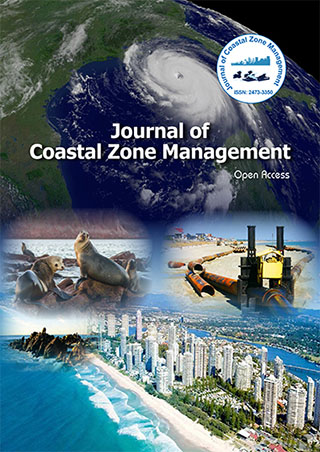Indexed In
- SafetyLit
- RefSeek
- Hamdard University
- EBSCO A-Z
- OCLC- WorldCat
- Publons
Useful Links
Share This Page
Journal Flyer

Open Access Journals
- Agri and Aquaculture
- Biochemistry
- Bioinformatics & Systems Biology
- Business & Management
- Chemistry
- Clinical Sciences
- Engineering
- Food & Nutrition
- General Science
- Genetics & Molecular Biology
- Immunology & Microbiology
- Medical Sciences
- Neuroscience & Psychology
- Nursing & Health Care
- Pharmaceutical Sciences
Commentary - (2022) Volume 25, Issue 10
The Importance of Beach Erosion, Managing Inlets and Changing Shorelines
Darrell Silva*Received: 04-Oct-2022, Manuscript No. JCZM-22-18645; Editor assigned: 06-Oct-2022, Pre QC No. JCZM-22-18645 (PQ); Reviewed: 21-Oct-2022, QC No. JCZM-22-18645; Revised: 31-Oct-2022, Manuscript No. JCZM-22-18645 (R); Published: 08-Nov-2022, DOI: 10.35248/2473-3350.22.25.525
Description
Beach erosion on nearby beaches will be reduced through improvements in sand bypassing at inlets, which may also result in a future requirement for less beach nourishment. Over a million cubic yards of beach-quality sand have been dumped on the downdrift beaches of Jupiter Island as part of the recently approved St. Lucie Inlet Management Plan, which is located in Martin County, Florida.
Mismanagement of sand resources is typically the cause of long-term, persistent beach erosion. The beaches downstream of Lake Worth Inlet in Florida are an example of how an inlet can induce beach erosion. Over the previous ten years, these beaches have lost more than 500,000 cubic yards of sand every year as a result of historical maintenance methods. By armoring more than 60% of the island's shoreline, Palm Beach Island has started a massive attempt to rebuild the 15.5 miles of beachfront that have been severely damaged. One might list numerous such instances of subpar inlet sand management techniques used along beaches facing the Atlantic, Gulf of Mexico, and Great Lakes shorelines.
Future beach maintenance expenses would drop dramatically with effective management of the country's coastal sand resources. The principal sand transport paths at each inlet would be better understood as a result of thorough investigations, and sand management strategies and plans to put corrective measures into place would be developed. Effective sand management plans would provide policymakers with a crucial tool for creating municipal, state, and federal policies.
Tidal inlets and river mouths break up normally continuous shorelines, and they are frequently the subject of human intervention, especially for navigation, such as the deepening of channels and the building of jetties. Sand is frequently deposited at the updrift jetty, on internal inlet and flood shoals, offshore, and at stabilised channel entrances as a result of natural ebb currents or necessary maintenance dredging. Sand from tidal inlets was excavated and dumped offshore for many years, far from the natural littoral system. According to Dean (1988), tidal inlets are responsible for 80 to 85 percent of the coastline erosion in Florida. The high costs of long-term, chronic erosion of downdrift beaches and the deterioration of biological resources, which frequently occur from the deposition of sand in bays, will be reduced by using sand bypassing techniques to restore the natural sand transport at many inlets. If not, chronic long-term degradation is likely to continue.
Shoreline changes
Due to the fact that more than 75% of the country's sandy shorelines are eroding, effective management will necessitate knowledge of coastal dynamics, which will be based in part on an analysis of historical changes recorded through surveys, historical maps, and aerial photographs to determine rates of erosion. Both developed and undeveloped shorelines experience erosion, which should be taken into account when choosing long-term management strategies.
Sand budgets for expansive littoral systems would improve the accuracy of the documentation of shoreline changes for the barrier island shorelines of the Atlantic and Gulf coastlines. A long-term database of shoreline positions is necessary for comprehensive recording. Generally speaking, historical data are scarce and do not fully capture the consequences of human involvement, which can have both positive and bad effects. Typically, episodic, seasonal, or storm-induced variations are not captured in historical images. High-resolution hydrographic (bathymetric) data collection will be necessary for the creation of long-term coastal management strategies. Thankfully, the development of the Global Positioning System (GPS) and other contemporary surveying methods has made it possible to quickly survey the nearshore zone with a high spatial density at a comparatively low cost.
For many years, there has been heated discussion about the sea level increase, most notably in relation to global warming. The Atlantic and Gulf coast barrier island shorelines as well as shorelines in the Mississippi Delta region have already experienced significant effects from the long-term rate of 1.2 millimetres per year, which is reportedly increasing and has rates that are approximately eight times higher than average due to regional subsidence. The typical global rates of sea level rise, according to a number of research on the effects of global climate change, are expected to be far higher than the current pace of 1.2 millimetres per year.
The total environmental quality of beaches, marine parks, estuaries, bay waters, and other coastal resources is frequently lowered by human activities—the very quality of these resources that supports tourism and enjoyment. The already few coastal resources are being put under more and more strain by tourists and developers. The conservation of the shoreline, monitoring, and educational initiatives should all be a part of a comprehensive environmental management programme that also includes recreational use and nature-based tourism.
Citation: Silva D (2022) The Importance of Beach Erosion, Managing Inlets and Changing Shorelines. J Coast Zone Manag. 25:525.
Copyright: © 2022 Silva D. This is an open-access article distributed under the terms of the Creative Commons Attribution License, which permits unrestricted use, distribution, and reproduction in any medium, provided the original author and source are credited.
